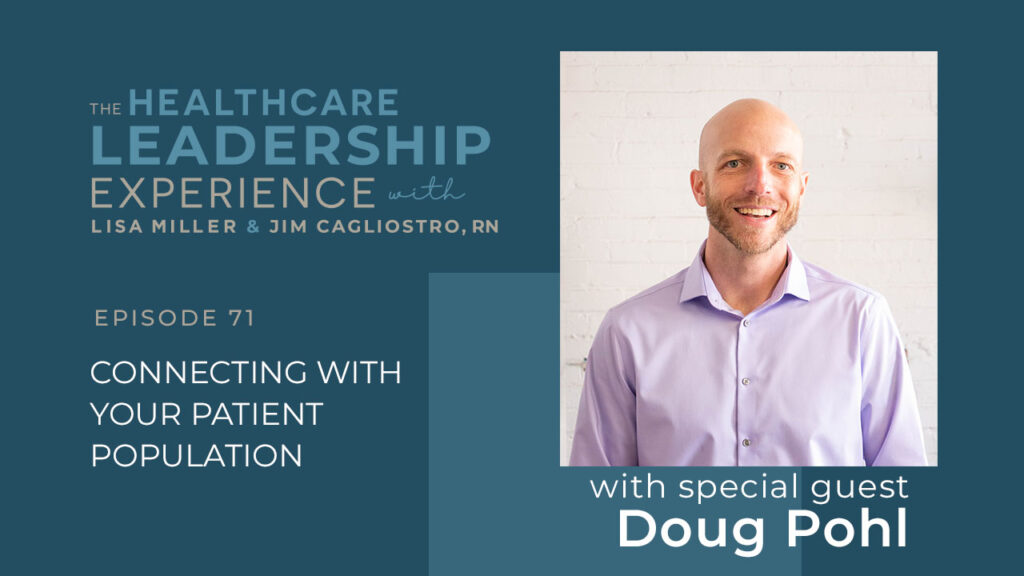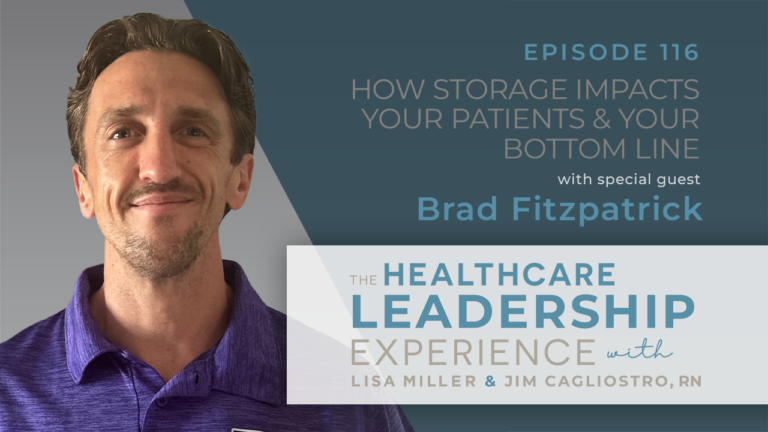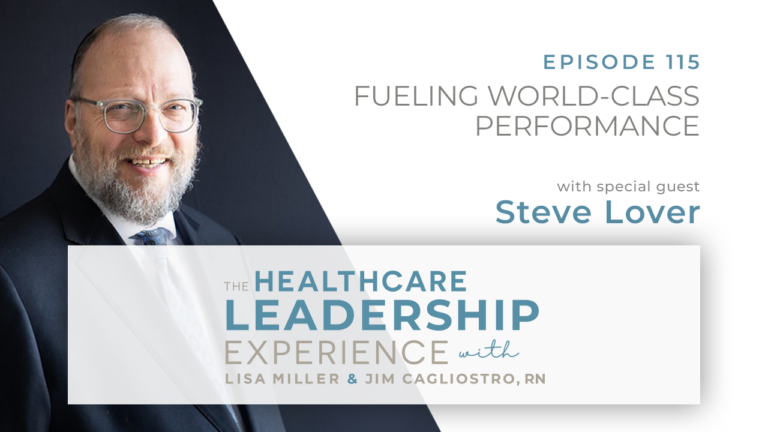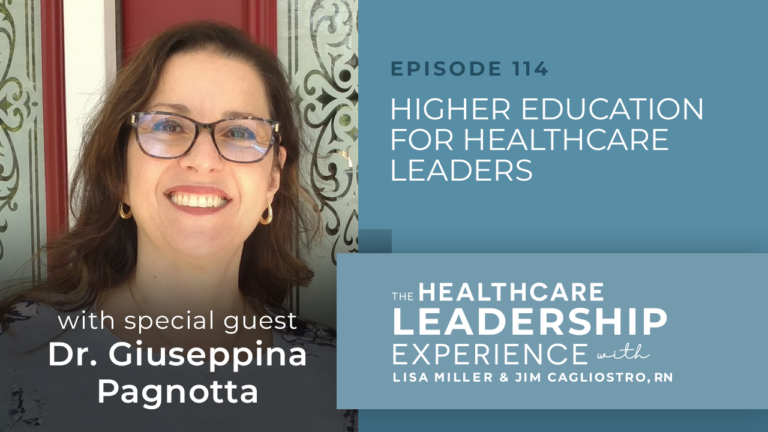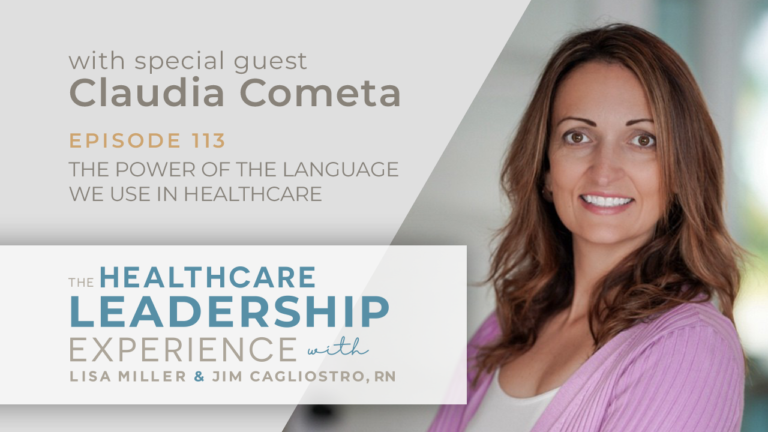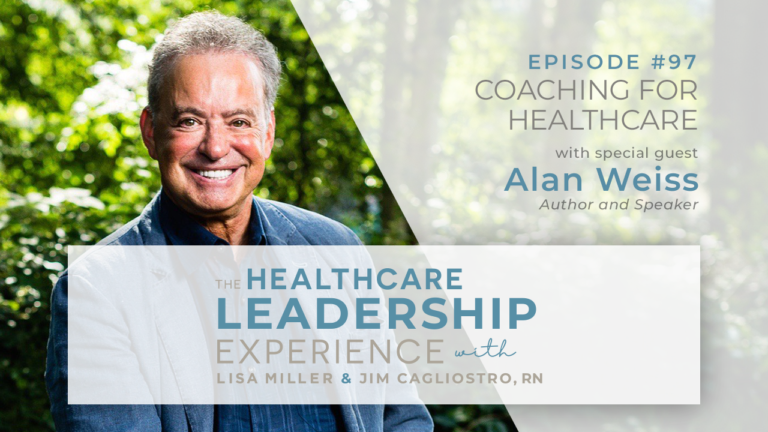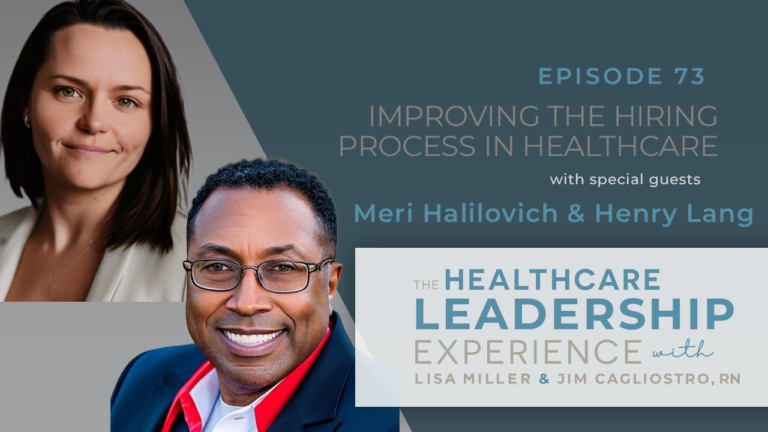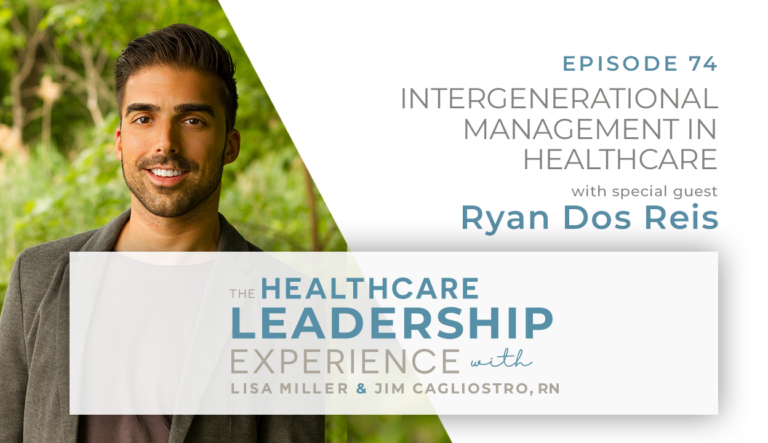Episode Introduction
Doug explains why hospitals need to prioritize ‘’humanity’’ over the bottom line, how to become a two-way mirror to build patient relationships, and why Business 101 is all about listening. He also shares how his experience as a singer/songwriter helped him to understand the power of storytelling, and why true leadership is about helping people climb the ladder.
Show Topics
- Hospitals need to focus on humanity in marketing
- Losing the community connection
- Healthcare marketing is a two-way mirror
- Business 101: It’s about listening
- Tapping into the power of storytelling
- Leadership is about helping people climb the ladder
06:54 Hospitals need to focus on humanity in marketing
Doug explained why the shift to ‘’consumers’’ from ‘’patients’’ creates a deeper problem.
‘’I feel like a lot of them are doing a decent job, in that there’s been this shift to people, you can’t necessarily even call them patients yet, but to view them as consumers. So, they market to us as consumers. And I get that, and I think it’s effective in some ways, but my personal view is if we’re treating people as healthcare consumers, there’s a deeper problem that we’re not addressing. And I think to ignore that is a long-term mistake. So, I think it’s really important that we focus on people’s humanity and do it in some powerful ways. You and I talked previously, there’s some commercials out there that tap into the emotions of what people are feeling when they go into a hospital, whether as a patient or a loved one or whatever the situation is, a clinician, whoever. Everyone has these strong emotions that come with them into a healthcare facility. And understanding those, having genuine empathy, feels like a weak word these days because we use it so often. But genuine concern for those feelings and for those people and wanting to help in real ways, even if it means less efficient business or a lower bottom line, but focusing on the heart and the emotions, I think is really the best path forward for marketing. And in my opinion, for operations in general.’’
09:13 Losing the community connection
Doug said the acquisition of a smaller hospital by a larger system pushes patients aside.
‘’ I think it sort of starts in-house with a disconnect with the clinicians and administrators and everybody who works in that system at that regional hospital, where they feel less of a connection with their organization, they feel like things are being imposed on them by the mothership, and all of a sudden everything’s changed. They feel a disconnect. They feel pushed aside. They feel like they’re not as important as they should be, and perhaps as they used to be. And I think there’s a trickle-down that comes from that. They pass on those feelings to the community, whether in the hospital or outside in their personal lives. It does change how people feel subconsciously, at least. I live in a small community, and we do have a small regional hospital that’s connected to a larger one, but we’re friends with the nurses and the doctors. We see them out in town and at the gym, and we talk to them, we hear their struggles, and we hear how tough it is for them. And so, these feelings are being shared in the community, and it does impact you as a patient that when it’s your turn, you go and you know what people are going through, and there’s this sort of inherent disdain for the organization as a whole because of it.’’
12:36 Healthcare marketing is a two-way mirror
Doug explained why every brand needs to reflect the audience back to themselves.
‘’In marketing, our job as a brand, any brand is to be a mirror, but it’s sort of a two-way mirror. So, we want to reflect the audience back to themselves. The things that bother them, their challenges, their pain points, whatever you want to call it, we acknowledge those. We say, “Here’s what’s going on with you, we understand your situation.” So, we reflect that, and we can do that not just by saying it, but we have to say it in the right way. So, we also reflect their exact words. That’s why getting those videos, those voice recordings are important. Hear that, get that voice of customer data, in this case patients or whoever it is, but get their actual words and use it. As an organization, you might call a certain program, you might have an in-house name for it. Let’s just use our imaginations here. But when you start marketing, people don’t understand that. And maybe you’re doing your research with your audience and you realize they’re actually using a different name for it. Well, name, use what people say and give it back to them. That helps them feel more connection, that sort of subconscious connection that we can’t measure, but it makes a difference. It really does. Once you have that and you genuinely understand, then you’re able to present your solution or offer it in a way that feels natural. It doesn’t feel salesy, it just feels like an extension of that connection.’’
16:31 Business 101: It’s about listening
Doug questioned exactly how much the needs of the patient are being heard today.
‘’How much listening is going on? Are organizations not just listening, but actually hearing and absorbing and really taking patient’s needs to heart? Yes, there has to be a balance with operations and with the financial concerns and all of that. I get it. But at the end of the day, none of that matters if patients aren’t happy. And I’m going to go back to the beginning here. There’s this trend of calling patients consumers. If your consumers aren’t happy, you need to change something. That’s the whole point of the business. You have to have people happy to get them to spend money, otherwise they’re going to go somewhere else, right? Business 101. So, I think the most effective way is to look at how we’re listening. What are we doing? Where can we improve to listen better? And once we listen, then what are we doing with that information? Are we genuinely being that mirror? Are we giving people what they want? Or are we just putting on a light patina onto what we wanted to do anyways?’’
18:15 Tapping into the power of storytelling
Doug said overlooking the human experience leaves out 80% of the marketing story.
‘’This is something I’ve been thinking a lot about lately. Stories are so powerful. It’s incredible. And back in my songwriting days, it was always about the story. I’d make a point to go talk with whoever I could, wherever I was at. I wanted to go talk with strangers and just get them talking, just hear their stories. And it’s amazing, people almost always want to share. I would write songs based on their experiences, based on what they told me. And those are the songs people love the best. They were real. They were actual stories that had a beginning, a climax and an end. And it was similar to their own lived experiences. So, again, it was taking people’s stories, hearing their own words, and feeding it back to the audience. And so, it’s the same thing that we can do with our marketing. We tell those stories. It’s not just a disease. It’s not just a treatment or a condition or whatever. It’s a real person, who has parents and children and jobs and concerns and bills and whatever. That’s all part of it. And to neglect all those different aspects of who they are, of what makes them human, that’s to leave out 80% of the story or more. That’s the meat that’s really going to help connect with people, because everybody has those things. Not everyone has… pick a condition. Not everyone has diabetes, but everybody has bills and parents and jobs or whatever. So, that’s how we connect, is by telling the whole story. It has to be a 360 view. And when we do that, I think it really opens up some amazing possibilities for what we can do, not only to create successful marketing, but to actually help and do what we’re trying to do with healthcare.’’
27:28 Leadership is about helping people climb the ladder
Doug said leading by example and turning to help others means everybody wins.
‘’My first management experience came from my job as a lifeguard in college in the summers. And my first year, I started off with a great manager who led by example. He never asked us to do anything that he wouldn’t do himself, and he made sure we all saw him do it first. And then when it was my turn to be manager, I didn’t do that. I was lazy, and I would just assume people knew that I could do things. And I learned very quickly that that was a big mistake. Now, what I try to show my team is, not only can I do it, but I can probably do it better than you because I have done it. I did it for years, and now I want to help you get to my level. So, then we can all grow, we can all benefit. Everybody wins. So, I think my leadership advice that I try to remind myself all the time is, lead by example and then turn around and help the next person up the ladder.’’
Show Links
Connect with Lisa Miller on LinkedIn
Connect with Jim Cagliostro on LinkedIn
Connect with Doug Pohl on LinkedIn
Check out VIE Healthcare and SpendMend
You’ll also hear:
‘’Everybody has a different story.’’ From professional country music singer/singwriter to healthcare content marketer. Listen to Doug’s unique journey.
Following your instincts and avoiding ‘’normal’’, how going with gut instinct was Doug’s trajectory. ‘’I’ve never wanted to be normal. In high school, that was my only trajectory, was just to do something different and just go with my gut.‘’
The power of storytelling: Why listening to people’s stories is the first step to connecting with your patients. ‘’Not because we have a particular end in mind, because we want them to support an idea or to reinforce something that we might already know, but genuinely because we care.’’
If a message misses the mark, it’s not the fault of our audience. ‘’Anytime we’re communicating, if someone’s not understanding us, we sort of put the blame on them, but really the onus is on us. So, the question should be asked, “How can I do better? What is it that I’m not doing or that I need to improve in order to help them understand what I’m trying to say?”
Giving data the time to filter through. Why healthcare’s unique nature means results take time. ‘’Anytime you’re working with people, it’s going to take a long time. So, you want to be flexible, but you need to allow the data to come in.’’
What To Do Next:
- Subscribe to The Economics of Healthcare and receive a special report on 15 Effective Cost Savings Strategies.
- There are three ways to work with VIE Healthcare:
- Benchmark a vendor contract – either an existing contract or a new agreement.
- We can support your team with their cost savings initiatives to add resources and expertise. We set a bold cost savings goal and work together to achieve it.
- VIE can perform a cost savings opportunity assessment. We dig deep into all of your spend and uncover unique areas of cost savings.
- If you are interested in learning more, the quickest way to get your questions answered is to speak with Lisa Miller at lmiller@spendmend.com or directly at 732-319-5700
Episode Transcript
DOWNLOAD THE FULL PDF TRANSCRIPT HERE
CLICK HERE TO OPEN THE FULL TRANSCRIPT
Doug (00:00):
… I think the most effective way is to look at how we’re listening. What are we doing? Where can we improve to listen better? Once we listen, then what are we doing with that information? Are we genuinely being that mirror? Are we giving people what they want, or are we just putting on a light patina onto what we wanted to do anyways?
Introduction (00:19):
Welcome to the Healthcare Leadership Experience Podcast, hosted by Lisa Miller and Jim Cagliostro.
Lisa is the founder of VIE Healthcare Consulting, and now managing director at SpendMend. Lisa and her team has generated over $1 billion in financial improvements for VIE’s clients since 1999.
Since 2007, Jim has been a registered nurse working in critical care, perioperative services, and outpatient settings at nationally recognized medical facilities across three states.
You’ll hear conversations on relevant and trending topics in healthcare and much more. Now, here’s your hosts, Lisa and Jim.
Jim (00:59):
Hi, this is Jim Cagliostro and you’re listening to the Healthcare Leadership Experience. Today’s guest is Doug Pohl, founder and CEO of HealthTech Content. We are excited to learn more about the world of marketing and healthcare, and how to more effectively connect with your audience. So Doug, welcome and thanks for joining us today.
Doug (01:18):
Oh, Jim, thanks so much for having me. I appreciate this.
Jim (01:20):
I always like to start with just telling us your journey. Can you share with us how you got into this space of healthcare, specifically healthcare technology, and then also into the marketing side of things? What prepared you for what you do now?
Doug (01:35):
Yeah. What’s interesting with marketers, I feel like, especially marketers who go on to found their own agencies, we get into it for very weird reasons, and I feel like we’re all kind of snowflakes in that way, where everybody has a different story. There’s no one path. And for me, I spent many years as a professional country music songwriter. So, I wrote a bunch of songs and recorded albums, toured, had other people record my music.
Jim (01:59):
So, Doug, I’m sorry to interrupt, but you’re going to sing one of those songs for us for the podcast, or no?
Doug (02:04):
Oh. I would, except…
Jim (02:08):
Next podcast. We’ll get you next time.
Doug (02:09):
There it is. Yeah.
Jim (02:09):
Sorry, go ahead.
Doug (02:12):
No, you’re good. Yeah, so I did that, and it was great. I did it for a long time, loved it. And of course, as every girlfriend’s father I ever talked with said, “So, there’s not much money in music, right son?” Which is very true. So, from time to time, I’d have to pick up a job here and there, and I didn’t realize it until after I started transitioning out of music that I actually had sort of a pattern that I was following, where I was both in healthcare and in marketing, and really didn’t even realize it in some ways.
Doug (02:46):
So, looking back, what I did was, while living in Houston, I worked for a medical device company for radiation oncology, and they had a product that they needed a little help promoting and had never done inside sales or any marketing. They had field reps across the country — but had never done anything in-house in this way. So, they asked me to essentially develop the inside sales program and all the marketing assets to go along with it. So, what I did, again, without really even knowing what I was doing or what it was called, I built a very detailed and also very manual one-to-one ABM campaign, where highly targeted for certain physicians, certain organizations, and just felt my way through that and stumbled into a pretty successful campaign. And it went really well, actually. So, that got me hooked. And-
Jim (03:36):
Doug, I’m sorry, but no formal training. It was really on the job like that. That’s great.
Doug (03:42):
Yeah. No, it was just the director of operations hired me actually to work in the warehouse. I was running their shipping and she saw something in me, I guess, thought that I was worth taking a chance on, so she let me take a stab at it. And yeah, I just dove in headfirst, no clue what I was doing, and made tons of mistakes, I’m sure.
Jim (04:01):
That’s how you learn best. That’s great.
Doug (04:03):
Right? Yeah. I loved it though. I really did. It was fun. So, from there, I moved on to the payer side. I worked for an insurance claims appeals processing company, which did not suit my personal interest. It was kind of boring in a lot of ways, but my specific role was pretty cool. I helped recruit physicians for specific cases, and it wasn’t just your normal GP down the street. This was looking for a very highly specialized, unique physicians who are tough to find, tough to get on the phone, and certainly tough to get them to share their time with us.
Doug (04:35):
So, it was my job to get them on board. And so, I got to have some really interesting conversations where I had to learn a lot about what they do and how it all works in their world so that I could have that conversation. And I think I got into… I sort of nerded out on the healthcare, the science of it. So, through all this, there’s lots of writing and content creation. I did freelance work in between as well. And I guess, I don’t know, a few years later I ended up heading up content for a software company based out of Australia as a practice management platform for Allied Health clinicians and clinic owners. And I was their sole content guy. And I think at that point they had tens of thousands of customers in 100 different countries, roughly. And that was fun for me because as an American writing for an Australian and British audience, I got to learn all the new spellings and grammars and the fun things Australians say. Man, they say fun things.
Jim (05:31):
Nice, nice. But yeah, there’s a learning curve there needed, I’ve experienced that myself. You know what I’m seeing though, well, as you’re sharing, obviously you have a personality, and we’ve talked a little bit before, and sometimes when it comes to marketing, personality does make a difference, but I’m definitely seeing a willingness to learn and the willingness to try something new. It seems like that’s kind of marked your career leading up to this point.
Doug (05:54):
Yeah, yeah. I love you said that, I’ve never wanted to be normal. In high school, that was my only trajectory, was just to do something different and just go with my gut. And if it felt right, then it was okay if it was hard — as long as it felt like it was me. So, yeah, that’s always kind of been my thing. I’m not sure where it’s taken me, but so far it’s worked out.
Jim (06:16):
Listen, I need you to give a pep talk to my kids. That’s great. We always try to encourage our kids, “Don’t worry about what the other kids are doing.” That’s great. So, you’ve kind of carved your own space here, and I know we’ve talked about this. In terms of hospitals and healthcare companies, we talk about missing the mark. Do you feel like some healthcare systems now, and obviously you’ve gotten to into the healthcare space with all this experience. If I cut you off, please add anything else in terms of what led you to this point, but what are hospitals missing in terms of knowing their audience? How do you feel we bridge that gap, in connecting hospitals and healthcare systems with their audience, with their patients?
Doug (06:54):
Yeah, that’s a tough one. And in some ways, I feel like a lot of them are doing a decent job, in that there’s been this shift to people, you can’t necessarily even call them patients yet, but to view them as consumers. So, they market to us as consumers. And I get that, and I think it’s effective in some ways, but my personal view is if we’re treating people as healthcare consumers, there’s a deeper problem that we’re not addressing. And I think to ignore that is a long-term mistake. So, I think it’s really important that we focus on people’s humanity and do it in some powerful ways.
Doug (07:32):
You and I talked previously, there’s some commercials out there that tap into the emotions of what people are feeling when they go into a hospital, whether as a patient or a loved one or whatever the situation is, a clinician, whoever. Everyone has these strong emotions that come with them into a healthcare facility. And understanding those, having genuine empathy, feels like a weak word these days because we use it so often. But genuine concern for those feelings and for those people and wanting to help in real ways, even if it means less efficient business or a lower bottom line, but focusing on the heart and the emotions, I think is really the best path forward for marketing. And in my opinion, for operations in general.
Jim (08:17):
As you’re talking, I know we didn’t discuss this prior, but you have mergers and acquisitions, and a lot of times, I guess my tendency is to think when a larger health system takes over a smaller community hospital, that sometimes that community hospital loses the connection with the community, or at least the freedom to feel like they can operate how they want to in order to connect with their patients, in order to connect with the people that live around the hospital. I don’t know if you’ve experienced any of that, or is that something that you would agree with? Because I’m just speaking from my personal experience, where I’ve been and what I’ve seen, where it’s a smaller hospital, they join a bigger network, a bigger health system, then sometimes they get lost in terms of, well, this is the way the mothership does it, if I can put it like that. Do you see that in your experience, or is that just something we’re assuming that’s not really accurate?
Doug (09:08):
Oh, I think it’s accurate. I think it’s hard to measure, but we all sense it, right?
Jim (09:13):
Sure.
Doug (09:13):
And I think it sort of starts in-house with a disconnect with the clinicians and administrators and everybody who works in that system at that regional hospital, where they feel less of a connection with their organization, they feel like things are being imposed on them by the mothership, and all of a sudden everything’s changed. They feel a disconnect. They feel pushed aside. They feel like they’re not as important as they should be, and perhaps as they used to be. And I think there’s a trickle-down that comes from that. They pass on those feelings to the community, whether in the hospital or outside in their personal lives. It does change how people feel subconsciously, at least.
Doug (09:53):
I live in a small community, and we do have a small regional hospital that’s connected to a larger one, but we’re friends with the nurses and the doctors. We see them out in town and at the gym, and we talk to them, we hear their struggles, and we hear how tough it is for them. And so, these feelings are being shared in the community, and it does impact you as a patient that when it’s your turn, you go and you know what people are going through, and there’s this sort of inherent disdain for the organization as a whole because of it.
Jim (10:22):
Yeah, that’s a great point. That’s great insight. So, especially bigger systems, but anybody can fall onto this in terms of missing the mark, what do you feel like, and you’ve kind of touched on this already, but what do you feel like organizations can do to better know, to better understand their customer base? I’m sure you’ve seen companies that struggle with it or organizations, hospitals, health systems, and I’m sure you’ve seen some health systems and hospitals that have excelled. What makes that difference in terms of connecting with the customer base?
Doug (10:50):
For me, it always comes back to the people, to the individuals, to seeking out their stories, their experiences. Not because we have a particular end in mind, because we want them to support an idea or to reinforce something that we might already know, but genuinely because we care. Say something like, “Your healthcare is important, we want to make sure that you’re getting what you need. Tell us about your experience.” And to constantly, it never ends. We should always be gathering this information, hearing people’s stories, not just a boring survey that’s more paperwork for people to fill out, but do it in ways that are convenient, that are easy, that are going to get people engaged and get them talking.
Doug (11:30):
I think video calls, voice messages, whatever, let people talk in their own words, let them say what they want to say and make it convenient for them so that we can actually tap into all of that. And when we do, then of course the hard part is then to act on it and to sort of distill it all down and find the action steps that need to be taken. But the first step is to listen.
Jim (11:54):
You’re bringing me back to nursing school. We talk about that therapeutic communication and just the presence and being someone in the room, rather than you’re the patient in the bed, and nobody’s there, no family’s visiting, but to be that presence in the room, that human touch, just someone to listen, that’s great, Doug. Thank you.
So, there is a difference. We’ve talked about this too. There is a difference between knowing your audience and effectively connecting with them. How would you explain that to our listeners? Explain that to me again. We can know our audience, but we might fail to effectively communicate with them. What can we do to connect with the audience better, whether it’s communication or what tools do we have?
Doug (12:36):
So, in marketing, our job as a brand, any brand is to be a mirror, but it’s sort of a two-way mirror. So, we want to reflect the audience back to themselves.
Doug (12:51):
The things that bother them, their challenges, their pain points, whatever you want to call it, we acknowledge those. We say, “Here’s going on with you, we understand your situation.” So, we reflect that, and we can do that not just by saying it, but we have to say it in the right way. So, we also reflect their exact words. That’s why getting those videos, those voice recordings are important. Hear that, get that voice of customer data, in this case patients or whoever it is, but get their actual words and use it. As an organization, you might call a certain program, you might have an in-house name for it. Let’s just use our imaginations here.
Doug (13:28):
But when you start marketing, people don’t understand that. And maybe you’re doing your research with your audience, and you realize they’re actually using a different name for it. Well, don’t use that name, use what people say and give it back to them. That helps them feel more connection, that sort of subconscious connection that we can’t measure, but it makes a difference. It really does. Once you have that and you genuinely understand, then you’re able to present your solution or offer it in a way that feels natural. It doesn’t feel salesy, it just feels like an extension of that connection.
Jim (14:03):
That’s a great point, Doug. And you mentioned the whole Australia, England, US, the language that we use, I don’t know if I shared with you in the past, but being clinical at the bedside my whole career, and then coming to work for VIE 2018, it was a whole new language I had to learn. There’s acronyms that we use on the business side of healthcare that are the same exact letters as what we use at the bedside, but mean something completely different. And what you’re saying is so important, I believe, in terms of using language, because when we communicate, it’s not about what the sender is sending, it’s about what the receiver is receiving, it’s if what I’m spitting out is not being received by anyone, I’m just blowing hot air. So, making sure that language is the right language that connects. And I love what you said in terms of presenting it naturally to the audience, so it doesn’t seem forced. It doesn’t seem something manufactured.
Doug (14:55):
Yeah. If our message isn’t landing, it’s not the audience’s fault. I don’t know if it’s a human instinct or just our society, I don’t know, but we as a people tend to have this knee-jerk reaction, say, “Well, what’s wrong with them? Why don’t they get it?” Anytime we’re communicating, if someone’s not understanding us, we sort of put the blame on them, but really on the onus is on us. So, the question should be asked, “How can I do better? What is it that I’m not doing or that I need to improve in order to help them understand what I’m trying to say?”
Jim (15:24):
Absolutely. Absolutely. If you’re just tuning in, you’re listening to the Healthcare Leadership Experience Radio Show, and I’m your host, Jim Cagliostro.
This show is sponsored by VIE Healthcare Consulting, a SpendMend company, which provides leading edge financial and operational consulting for hospitals, healthcare institutions, and other providers of patient care.
Since 1999, VIE has been a recognized leader in healthcare costs, hospital purchase services, healthcare benchmarking, supply chain management, and performance improvement. You can learn more about VIE Healthcare Consulting at viehealthcare.com.
Jim (16:00):
So, Doug, you may have heard patients say, I’ve heard patients say things like, “Well, hospitals don’t get it,” or “They’re just in it for the money. They’re not giving me what I need.” Today, what do you think are the most effective ways to connect to patients when it comes to what they need in terms of meeting their expectations and meeting their physical needs, their healthcare needs?
Doug (16:24):
Patients’ feelings in those regards, what you described there, that’s nothing new. It’s been going on for years. Years.
Jim (16:30):
Of course. Sure.
Doug (16:31):
And yet, how much listening is going on? Are organizations not just listening, but actually hearing and absorbing and really taking patient’s needs to heart? Yes, there has to be a balance with operations and with the financial concerns and all of that. I get it. But at the end of the day, none of that matters if patients aren’t happy. And I’m going to go back to the beginning here. There’s this trend of calling patients consumers. If your consumers aren’t happy, you need to change something. That’s the whole point of the business. You have to have people happy to get them to spend money, otherwise they’re going to go somewhere else, right? Business 101.
Doug (17:09):
So, I think the most effective way is to look at how we’re listening. What are we doing? Where can we improve to listen better? And once we listen, then what are we doing with that information? Are we genuinely being that mirror? Are we giving people what they want? Or are we just putting on a light patina onto what we wanted to do anyways?
Jim (17:31):
Actually, I’m going back to church on Sunday, and I heard that the preacher was saying, “We can hear something, but are we really listening? Are we listening with our minds? Are we listening with our hearts? Are we really trying to…” That word, empathy. Are we showing concern for the individual, or am I just hearing it because that’s what I’m supposed to do? So, are we truly listening? And I know Doug, we’ve talked about storytelling, and I know you’ve kind of touched on that, but that is a big part of listening. So, how do we, as healthcare organizations, how do we as hospitals, as those who are marketing for healthcare technology and for hospitals, how do we use storytelling as a way to connect with our audience, to connect with consumers, to connect with patients?
Doug (18:15):
Yeah, man, this is something I’ve been thinking a lot about lately. Stories are so powerful. It’s incredible. And back in my song writing days, it was always about the story. That’s how you explain things to people, I’d make a point to go talk with whoever I could, wherever I was at. I wanted to go talk with strangers and just get them talking, just hear their stories. And it’s amazing, people almost always want to share. You know they want to talk –
Jim [18:39]
Sure
Doug (19:03):
… so they would. And then I would write songs based on their experiences, based on what they told me. And those are the songs people love the best. They were real. They were actual stories that had a beginning, a climax and an end. And it was similar to their own lived experiences. So, again, it was taking people’s stories, hearing their own words, and feeding it back to the audience.
Doug (19:03):
And so, it’s the same thing that we can do with our marketing. We tell those stories. It’s not just a disease. It’s not just a treatment or a condition or whatever. It’s a real person, who has parents and children and jobs and concerns and bills and whatever. That’s all part of it. And to neglect all those different aspects of who they are, of what makes them human, that’s to leave out 80% of the story or more. That’s the meat that’s really going to help connect with people, because everybody has those things. Not everyone has… pick a condition. Not everyone has diabetes, but everybody has bills and parents and jobs or whatever. So, that’s how we connect, is by telling the whole story. It has to be a 360 view. And when we do that, I think it really opens up some amazing possibilities for what we can do, not only to create successful marketing, but to actually help and do what we’re trying to do with healthcare.
Jim (20:06):
That’s great, Doug. This is right in my lane, Doug. I love this stuff, all about really, the patient experience. We talk about patient-centered care, and then you’ve heard the term family-centered care. And to not just forget, this is just a body that’s going through a physical ailment. No, this is a person who has the financial struggles, who has the relationship issues, them being in the hospital or them dealing with this ailment, that’s affecting everything else. And we can’t forget about that. And listening to that story. But then also, I know you’ve talked about telling that story or sharing that story with, whether it’s staff that can say, “Hey, this is a bad experience that a patient had. How can we improve on it?”
Jim (20:46):
And you mentioned earlier acting on, we can listen, yes. But then we need to act on it. That’s sometimes the challenge, what’s the appropriate response? So, why, and you did touch on this, but why do you think that storytelling is so effective as opposed to, I don’t know, other approaches in marketing? I’m sure being in the marketing space, that there’s other means by which you can connect with an audience. Why does storytelling stand out above and beyond some of these other approaches?
Doug (21:14):
I think in a lot of ways, it’s biological, it’s evolutionary. Storytelling and stories in general are how we evolved as a species to become as successful as we are now. It’s how we were able to communicate the idea of time and tools and resources and how to work as a group, how to survive. It was through stories, even simple stories, like, “This is how you start a fire.” Right?
Jim (21:39):
Sure.
Doug (21:40):
Something like that. We can pass ideas along, ideas, these intangible things, but now we can share them. But it’s with stories. If we see a bullet list or just news headline or something, we get an idea, but then two seconds later, we get another idea and that first one’s gone. But because of how we’re hardwired neurologically, stories stick in our brains. They do. Not all of them, but a good one will stick in the brain. And that’s what makes them so powerful, is the long-lasting impact it can have on us. When two weeks later, we’ll remember that story, or we’ll share it with someone else. And then that idea’s getting passed along. You’re not going to see a bullet list and then pass that along to somebody two weeks later.
Jim (22:24):
Absolutely.
Doug (22:25):
…or you will. That’s what makes them so powerful, I think.
Jim (22:28):
That’s a great point. And again, you’re bringing me back to, I’m taking notes from my parenting here with the kids. You try to tell them something, I’m giving them 100 reasons why they have to eat a certain way or do something for their safety. But if you tell them a story, I’m amazed at our kids, who can just recall something that we talked about two years ago, and I had lost all memory of it, but the story sticks with them. And as a nurse, I do appreciate the data. We need a good sample size in order to justify a certain decision. Yes, 100%. But to really effectively communicate the reason for changing, I think including a story to reinforce the data, to reinforce the message that you’re trying to convey, the stories are so powerful. I love how you laid that out. I love how you explained that.
Doug (23:16):
Yeah, I think it is really powerful. And kids are huge. I told my son about a time when I was in elementary school, I think it was fourth, fifth grade, and a bird pooped on my buddy’s head. I just told him this story. I wasn’t thinking, I was probably just driving and keeping him entertained. Months and months later, he’s still talking about that. And he’ll share it with strangers on the street because-
Jim (23:37):
That’s funny.
Doug (23:38):
… he remembered it. But when I tell him he needs to brush his teeth, well, that conveniently gets forgotten a lot.
Jim (23:44):
Absolutely. Yes. I know. We got a four-year-old, and yes, we’re right in that same boat. So, I’m thinking now in terms of health systems and hospitals, whoever’s responsible for marketing with a big health system and whatever they were doing for marketing had been effective, or maybe there was no competition in the area, now another health system reaches into the area. Or maybe they’re just not connecting with their audience as much. And we’ve talked a little about this too, in terms of the need for flexibility, in terms of strategy. And we say, “Hey, what we were doing was working, but for whatever reason, it’s not working in terms of marketing, in terms of connecting with the audience.” So, can you share why some organizations maybe struggle with adapting a strategy and why it’s vital for this adaptability, especially in marketing and especially in healthcare.
Doug (24:37):
Yeah. So there’s a million different reasons, and everybody’s going to have a different situation. But in general, if something’s working, we want to keep it going. So, we might overlook the significance of a particular situation by just saying, “Well, we need to make a tweak here, a little change there.” And we wake up further down the line and realize, “Well, we missed the mark a long time ago.” This new competitor in the market or whoever, whatever the situation is, they’re having a bigger impact than we realized, and now all of a sudden it feels like this huge emergency. So, I think the first thing is vigilance, to always have that open mind. Maybe something bigger is happening, probably not, but it’s always a possibility so you want to make sure that hat’s at least a question that’s asked, and given genuine attention. And then, remind me the second half of your question there.
Jim (25:24):
Some organizations aren’t flexible, but why is it vital? You kind of answered that, and this whole conversation is really brought to light just this idea of, you kind of mentioned it there, where maybe it’s not something we just did this week that’s affecting it. It could have been a decision we made down the road, but we didn’t really see the impact of it until further along. So, you answered the question, unless there’s anything you want to add in terms of the flexibility needed. In nursing, we talk about that all the time where, hey, a certain approach isn’t working for these types of patients. Well, what about this… sometimes we go back to a medication that was used 20 years ago that kind of fell out of favor, but now we’re starting to use that again. So, I think just this need to be flexible in healthcare can really go beyond just the bedside and really look at the marketing and connecting with the audience.
Doug (26:13):
Yeah, it really can. And I think what sort of makes it tough and unique in healthcare is how long it takes to see the results. So, the results that we’re seeing now are because of changes that were made maybe three years ago.
Jim (26:26):
Right.
Doug (26:26):
And it just takes that long. Anytime you’re working with people, it’s going to take a long time. And so, it takes a long time. So, then you want to be flexible, but at the same time, you need to allow the data to come in, let ideas and implementations do their thing before you go messing with them, because in marketing, it happens all the time. You start a campaign, oh it’s not working. You make a big change and you could have had a big win, but you messed it up.
Jim (26:51):
Sure.
Doug (26:51):
So, being flexible is important, but I also acknowledge that we need to make sure that we’re working with the correct perspective and giving data the time to actually come in and get the full picture of what’s going on.
Jim (27:02):
Great. Great. Well, Doug, I’ve really enjoyed the conversation. I always like to end our time, especially with your wide range of experience and how you’ve kind of gotten to where you are today, is there any leadership insight or advice, something that you feel you’ve learned along the way or you’ve developed as your approach in terms of leadership, or specifically leadership in healthcare that you want to leave our audiences with, that you want to share with us today?
Doug (27:28):
Yeah. My first management experience came from my job as a lifeguard in college in the summers. And my first year, I started off with a great manager who led by example. He never asked us to do anything that he wouldn’t do himself, and he made sure we all saw him do it first. And then when it was my turn to be manager, I didn’t do that. I was lazy, and I would just assume people knew that I could do things. And I learned very quickly that that was a big mistake. Now, what I try to show my team is, not only can I do it, but I can probably do it better than you because I have done it. I did it for years, and now I want to help you get to my level. So, then we can all grow, we can all benefit. Everybody wins. So, I think my leadership advice that I try to remind myself all the time is, lead by example and then turn around and help the next person up the ladder.
Jim (28:20):
That’s great. Thank you, Doug. Leading by example, and I love, you took it that next step that I really haven’t heard people share before. You’re not just leading by example and doing it just to go through the motions, just so everyone can see you’re doing it, but you’re actually doing it well, and you’re going to do it to the best of your ability. And people will see that and recognize it. That’s great advice, Doug. Thank you so much for being on the show today.
Thank you to our listeners, who spent time with us today. If you have any questions about VIE Healthcare Consulting, a SpendMend company, or if you want to reach out to me or Lisa Miller, you can find us on LinkedIn. Doug is also active on LinkedIn. I love the stuff that he posts, so please follow him.
We at VIE love helping hospitals save money and enhance the patient experience, and we’re hoping that the episode today gave you some new insights or ideas to consider and use in your career in your own healthcare organization.
So, Doug, thank you once again for being on the show with us today.
Doug (29:14):
Oh, thank you so much, Jim. This was great. I really appreciate the opportunity.
Jim (29:17):
Our pleasure.
Announcer (29:18):
Thanks for listening to the Healthcare Leadership Experience Podcast. We hope you’ve enjoyed this episode. If you’re interested in learning new strategies, best practices and ideas to utilize in your career and healthcare organization, check out our website at thehealthcareleadershipexperience.com. And oh yeah, don’t forget to rate and review us, and be sure to join Lisa and Jim next time on the Healthcare Leadership Experience Podcast. Thanks again for listening.
